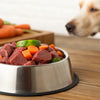Can You Freeze Raw Dog Food? A Comprehensive Guide for Pet Parents
- Houndsy
Table of Contents
- Introduction
- Understanding Raw Dog Food
- The Importance of Freezing Raw Dog Food
- How to Thaw Raw Dog Food Safely
- Safe Handling Practices for Raw Dog Food
- Special Considerations for Different Types of Raw Dog Food
- Conclusion
- FAQs about Freezing Raw Dog Food
Introduction
As dedicated pet owners, we constantly seek ways to provide our furry friends with the best care possible. With more dog owners transitioning to raw diets, understanding proper food storage is crucial. Did you know that improper handling of raw dog food can lead to health risks for both dogs and humans? A staggering 70% of pet owners are unaware of optimal storage practices, often putting their pets at risk. This blog post aims to demystify one of the most frequently asked questions among raw feeders—can you freeze raw dog food? By the end of this guide, we will clarify the best practices for freezing, thawing, and serving raw meals, ensuring you keep your beloved pet safe and happy.
In this article, we will cover the importance of freezing raw dog food, the benefits it provides, safe thawing methods, as well as handling practices to ensure cleanliness and safety. We will also touch on FAQs and special considerations for different types of raw food. Together, we can simplify the feeding process and make raw diets more convenient while enjoying the delightful experience of keeping our dogs nourished with quality food.
Understanding Raw Dog Food
Before diving into freezing practices, let’s explore what raw dog food entails. Raw feeding typically includes uncooked meat, bones, fruits, and vegetables, offering natural nutrition that can boost your dog's overall health. By feeding our dogs a raw diet, we are potentially improving their coat condition, reducing allergies, and enhancing their immune responses. However, this type of diet also necessitates a strong commitment to safe handling and storage practices to prevent contamination.
Nutritional Benefits of a Raw Diet
To understand why pet owners opt for raw feeding, let’s consider the benefits:
- Improved Digestion: Raw diets often contain more moisture, which promotes better hydration and digestion.
- Shinier Coats: The high-quality fats and oils present in raw diets often result in healthier, shinier fur.
- Increased Energy Levels: Many pet owners report heightened energy levels in their dogs after transitioning to a raw diet.
- Better Weight Management: Raw feeding allows owners to control portion sizes easily, which can lead to healthier weight maintenance.
These benefits make raw feeding an attractive option. However, improper storage of raw dog food can diminish these advantages, hence the question—can you freeze raw dog food?
The Importance of Freezing Raw Dog Food
Why Freeze Raw Dog Food?
The primary reason to freeze raw dog food is to prolong its freshness and safety. When stored appropriately, freezing extends the shelf life of raw ingredients, making it easier to manage your dog's meals without stress or waste. Freezing acts as a safeguard against spoilage, which can happen faster with raw meats compared to processed foods.
Benefits of Freezing Raw Dog Food
-
Prevention of Bacterial Growth: Freezing raw food significantly slows down the growth of harmful bacteria, ensuring that your dog consumes safe food.
-
Storage Flexibility: With frozen raw food, you can buy in bulk, allowing for flexibility in your meal planning.
-
Easy Meal Prep: Pre-portioning and freezing meals make it easier to serve the right amount at feeding time with minimal fuss.
Guidelines for Freezing Raw Dog Food
To maximize the benefits of freezing raw dog food, ensure you follow these guidelines:
Choosing the Right Containers
-
Airtight Containers: Use airtight, freezer-safe containers that can prevent air exposure and freezer burn.
-
Portion-Sized Packs: Consider using resealable freezer bags or vacuum-sealed bags to hold single meals. This not only simplifies thawing but also makes it easy to manage serving sizes.
How Long Can You Freeze Raw Dog Food?
Raw dog food can be stored in the freezer for several months—up to six months or longer—without losing its nutritional value. However, always check the expiration date of the ingredients and monitor for any changes in odor or texture.
How to Thaw Raw Dog Food Safely
Thawing is as crucial as freezing. Improper thawing can lead to bacterial growth, which poses health risks. Here are the safest methods:
1. Refrigerator Thawing
The safest way to thaw frozen raw dog food is by placing it in the refrigerator.
- Process: Place the container of frozen raw food on a plate to catch any drips and let it thaw overnight.
- Safety: This method ensures the food remains at a safe temperature throughout the thawing process (40°F or lower).
2. Cold Water Bath
If you require a quicker option, use a cold water bath.
- Process: Seal the raw food container in a plastic bag and submerge it in cold water. Change the water every 30 minutes to maintain a safe temperature.
- Time: This method typically takes a few hours, depending on the size of the portion.
3. Directly in Your Pet's Bowl
Some products are designed for quick thawing. You can place thawable raw food directly into your dog’s bowl, and it will thaw out in a short time.
4. Avoid Microwave Thawing
While tempting for quick results, microwave thawing can create hot spots that promote bacterial growth and compromise the food's nutritional integrity. Always avoid this method!
Safe Handling Practices for Raw Dog Food
Ensuring food safety does not stop at freezing and thawing. Always follow proper handling practices:
Hygiene Practices
-
Wash Hands: Wash your hands thoroughly with soap and water before and after handling raw dog food.
-
Sanitize Containers: All bowls, utensils, and surfaces used for raw food should be cleaned immediately to prevent cross-contamination.
-
Separate Storage: Stock your dog’s raw food away from human food in designated areas or dedicated freezers.
-
Monitor Freshness: Any thawed foods should be consumed within 3 days if stored in the refrigerator. After that, discard any uneaten portions.
Special Considerations for Different Types of Raw Dog Food
1. Meat
Ground meats, chicken, and beef should be frozen and stored in single-meal portions. If you buy in bulk, ensure you separate them into manageable sizes before freezing.
2. Fish
Fish can harbor parasites. Freezing fish at 0°F or lower for at least two weeks is crucial to eliminate these risks.
3. Organs and Bones
Freezing organ meats and bones is also safe, but ensure that you follow the recommended portion sizes and practices discussed above.
Conclusion
Feeding our dogs a raw diet is an excellent way to keep them healthy and vibrant, but it requires conscientious handling and storage. By understanding how to freeze raw dog food properly and integrate safety practices, we can remove the worry from raw feeding and focus on providing the best nutrition for our pets.
If you're looking to further elevate your dog's feeding experience, consider exploring the Houndsy Kibble Dispenser for innovative feeding solutions that bring convenience and style right to your home. Order your Houndsy Kibble Dispenser today!
FAQs about Freezing Raw Dog Food
Can you refreeze thawed raw dog food?
Refreezing thawed raw dog food is generally not recommended as it can increase the risk of bacterial growth. Instead, focus on using it within a few days once thawed.
How long can you keep frozen raw dog food?
Frozen raw dog food can last between 3 to 6 months or more in a consistent freezer temperature of 0°F.
How do you know if raw dog food has gone bad?
Signs include off-smells, changes in color, or an unusual texture. If in doubt, it's best to discard it for safety.
Is raw dog food safe for puppies?
Yes, raw dog food can be safe for puppies, but be sure it contains balanced nutrition tailored to their growing needs.
Do you need to supplement raw dog food?
Depending on the recipe and variety, you may need to consider supplements to ensure a balanced diet. Consulting a vet is advisable.












